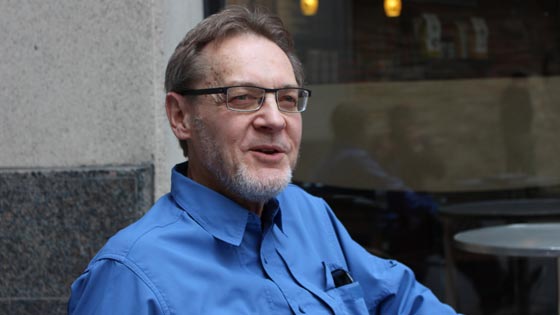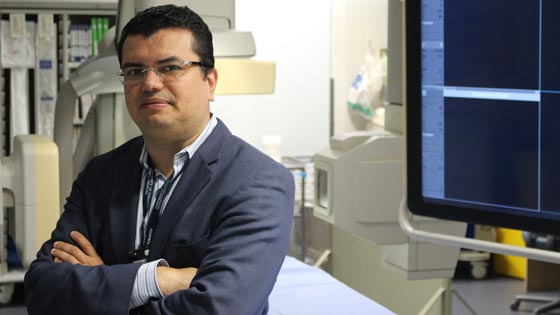
Toronto grandfather Vernon Paige still can’t believe how fast he was treated by the stroke team at the Krembil Neuroscience Centre after he had a stroke in July, 2015. (Photo: UHN)
Vernon Paige was craving a coffee when a sudden medical emergency turned his life upside down.
Expecting large crowds, and hoping to avoid them, the semi-retired accountant and his wife Cheryl arrived early at the rhythmic gymnastics final at the Pan Am Games in Toronto on July 20, 2015.
"After finding our seats I went searching for that coffee," Vernon recalls. "I remember the crowds were starting to come in. There were a lot of people. Someone bumped my shoulder and swung me one way. Then somebody else knocked my other shoulder. I got jostled, lost my balance and fell to the ground."
Fortunately, six paramedics setting up equipment a few feet away sprang into action.
"Somewhere around that time I had a stroke," Vernon says. "I lost the strength in my left arm and my left foot. One of the paramedics kept asking me questions, but I was starting to slur my speech. They gave me a mild sedative. I didn't feel like I was having a stroke."
June is Stroke Awareness Month
Despite being taken to hospital by ambulance with lights flashing and sirens blaring, Vernon had yet to realize the seriousness of the situation. The Toronto grandfather of four is sharing his story to help raise awareness for Stroke Awareness Month, which takes place every June. In recognition of the occasion, the stroke team at Toronto Western is setting up an information booth and a blood pressure clinic in the atrium on June 15 where staff can learn more about prevention and the signs of stroke. Additionally, Dr. Frank Silver and Kathy Cohen of the Stroke clinic will join a stroke survivor to discuss the topic in depth in the Toronto Western Auditorium on June 24.
"I wasn't quite sure what was going on," Vernon says of the ambulance ride. "I was actually quite relaxed. I was thinking 'Well, I hope we get back in time for the Games.'"
What Vernon didn't know is that his condition had triggered a fan out page to the code stroke team at Toronto Western Hospital (TWH). Nurses, doctors, CT (computerized tomography) technologists, interventional radiology staff and emergency department staff were among those preparing for the arrival of a patient showing acute stroke symptoms.
"If our team is aware, then we are already in the emergency department waiting for the patient to arrive," says Dr. Leanne Casaubon, a neurologist at the Krembil Neuroscience Centre (KNC) and Director of the Transient Ischemic Attack Minor Stroke (TAMS) unit.
"The minute that a patient is registered they go directly to have a CT scan where we do advanced neuro-imaging," says Dr. Casaubon. "The scans give us a picture of the whole anatomy of the blood vessels so as we plan treatments, we know what we are dealing with."
Clock is ticking in stroke cases
Within 15 minutes of arriving at the hospital, interventional neuroradiologist Dr. Vitor Mendes Pereira was reviewing Vernon's CT and CT angiogram scans looking for clues that would tell him what caused the stroke and whether it was possible to mechanically remove the clot.
"The scans allow us to see exactly where a clot is, determine the size of the clot and find the pathway we need to follow to go get it," says Dr. Pereira.
The clock is ticking in stroke cases. Most treatment needs to be administered within a very short window, generally less than five hours since the last time a patient appeared to be acting normal or was "last seen well."

Interventional neuroradiologist Dr. Vitor Mendes Pereira performed the endovascular procedure to remove the clot in Vernon’s brain in a neuro-angiography suite at the Krembil Neuroscience Centre. (Photo: UHN)
Imaging revealed a large clot
In Vernon's case, thanks to the observations of the paramedics, the team was able to pinpoint the exact time he first showed signs of stroke.
Dr. Pereira says the imaging revealed a large clot blocking the main cerebral artery branch in Vernon's head. He was diagnosed with having a right intracranial internal carotid artery territory ischemic stroke. The treatment in such cases consists of the injection of the clot-busting drug tPA and an interventional procedure to remove the clot called mechanical thrombectomy.
"The procedure entails inserting a catheter (tube) into an artery near the groin and using image-guiding technology to thread a stent retriever through the patient's body and into the brain," says Dr. Pereira, who performed the procedure in a state-of-the-art neuro-angiography suite at TWH that is specifically equipped to treat complex neurovascular diseases.
"Once located, the clot is retrieved and removed and blood begins to flow again in that part of the brain."
Before endovascular treatment became standard practice less than two years ago, the outcomes for patients like Vernon were poor.
"A very large proportion would not be able to return home. A large proportion would not even be eligible for rehabilitation," says Dr. Casaubon.
Just over an hour
"It's incredible how fast the procedure happened. I had the stroke between 9:15 and 9:30 a.m.," says Vernon. "The next thing I remember, I look up and Dr. Pereira and Dr. Casaubon say, 'Well, we're done'."
"The whole thing took just over an hour."
Afterward, Vernon was moved to the Intensive Care unit where he had one thing on his mind: "I was thinking 'I never got that coffee, how about that coffee'?"
At first, the medical staff said Vernon might need to spend weeks or even months recovering.
"The thing is, I really felt fine. I didn't have the same level of strength in my left arm and leg, but other than that, I was feeling OK. I wanted to go home."
Within a few hours he was back on his feet proving that there were no serious side effects. Two days later, after incessantly lobbying the medical staff, he was sent home.
"When you look at a person who received the acute stroke treatment, including the tPA and the endovascular treatment, to go home in two days, that is an exceptional outcome compared to the usual outcomes in the patient population before this treatment became the standard of care," says Dr. Casaubon.
It's not realistic for patients to expect to go home after two days, and without rehabilitation, but the fact is the stroke team is seeing more and more of it.
"In medical centres experienced in acute stroke treatment, this procedure can be performed extremely fast," says Dr. Timo Krings, Head of the Division of Neuroradiology and Site Chief of Medical Imaging at TWH. "This breakthrough technology is leading to better outcomes for stroke patients."
New lease on life
In Vernon's case, he reports no major side effects, except for a touch of pain immediately after the stroke when running his hands under hot or cold water.
In many ways, surviving the stroke has given him a new lease on life. It reinforced his appreciation of art, music, food, reading and travel. He and wife Cheryl are spending time this summer at a cottage in Sauble Beach and planning a fall getaway to Maine.
Looking back, Vernon realizes how fortunate he is to have shown signs of stroke in front of the paramedic staff and that he was treated at TWH.
"To the team at Toronto Western and the Krembil Neuroscience Centre, I just want to send a heartfelt thank you for saving my life," says Vernon.
"You have given me the gift of many more years of good health and time with my family that I will enjoy and cherish."
